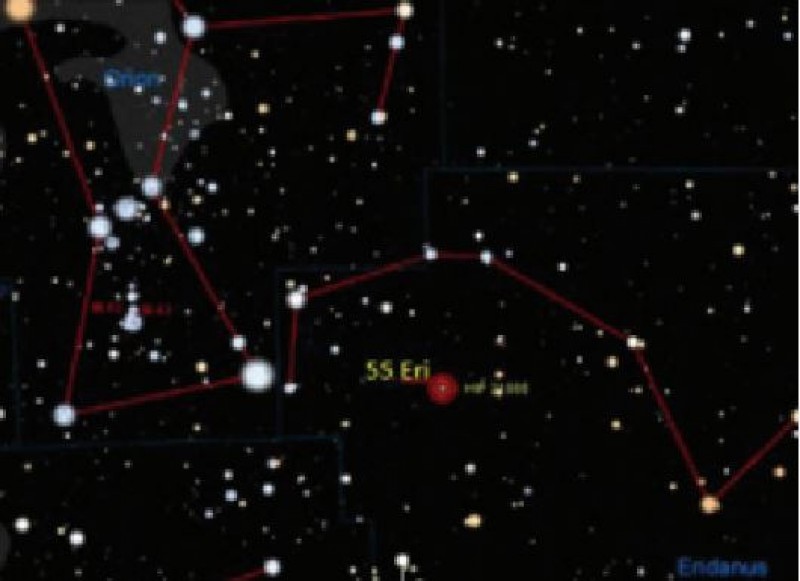 |
| Here is a finder chart for 55 Eridani generated by TheSkyX by Software Bisque. SkyX is software that can help beginning appreciate what they're learning, help intermediate astronomers find what they're trying to find and help serious and pro-level astronomers reach new heights. For both Mac and Windows. |
Object: 55 Eridani, SAO131443, STF590
Class: Double Star
Constellation: Eridanus
Magnitude: 5.98 (6.7, 6.8)
R.A.: 4 h, 43 m, 35 s
Dec: -8° 47’ 40”
Size/Spectral: F4
Separation/PA: 9.2 arc seconds; 317 degrees
Distance: 406 ly
Optics needed: A small telescope
If you’re a reader of Astronomy magazine you may have run across Glenn Chaple’s article in the March, 2017 issue called “Double star marathon redux”. The idea is to create a double star marathon list to complement the Messier list. Most of us know that in March it’s possible to see all the Messier objects in a single night. If a Messier marathon isn’t enough for you, try the double-star marathon.
The Messier list is 110 objects, and the double star list is 110 double stars. Any chance you could complete them both in a single night?
There’s not much that can compete with double stars for observing opportunities.
- They’re often bright pairs
- Visible even in light polluted skies
- They don’t require large optics (but do require good optics)
The star pair that I’ve chosen from Glenn’s list is a good one in that it is relatively bright, the stars are within .1 magnitude of each other, and the separation is large enough that even modest telescopes will split it easily.
Like most stars, this one exists in several catalogs, Flamsteed (55 Eri), Smithsonian Astronomical Observatory (SAO 131443, and the Struve catalog of double stars (STF590). My computer based sky map (TheSky X) finds the star for any of these designations, but requires the text ‘STRUVE 590’ to find it using the STF catalog.
I remember a night, long ago, when I was at the HAS observing site with my 15” dob. I had completed my list of 6 objects for that night, so I found an article by Sissy Haas (Sky and Telescope) on double stars and thought I’d give these a try. I did and was delighted to see a wide array of double stars on that night. There were some pairs that were close enough and so similar in magnitude that I couldn’t help but think of these as headlights on a dark road, or the eyes of an animal lurking in the night.
The Astronomical League has a double star award, and I encourage you to work on that program. If you observe 55 Eri, you’ll have completed one of the stars on the list. (You’re obliged to draw the double star as part of the program.)
The combined color of the two stars is F4, which puts it in the middle of the color spectrum. Only about 1/3 of the stars in the sky are F stars, and, recalling that the original list of star colors was in order of the strength of the hydrogen line in the star’s spectra, we should expect that this star would have a rather weak hydrogen line. In fact, F stars have strong calcium absorption lines. These absorption lines occur in the outer atmospheres of stars and give astronomers clues about the history of the star.
This star is available in March early in the evening with a local transit time of about 20:15. If you have electronic setting circles or a go-to telescopes, it’ll be easy to find.
-- By Bill Pellerin. Originally published in GuideStar 3/17, the magazine of the Houston Astronomical Society.